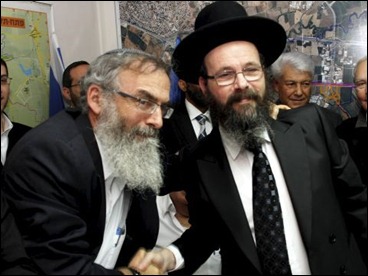Yesterday, two new rabbis were elected to the post of “city rabbis” in Petach Tikva. After three years of political wrangling, a deal was struck between the charedi Shas party and the national-religious Mafdal party. The brother of a Shas minister was elected as the Sephardi rabbi (no surprises here), and Micah HaLevy was elected as the Ashkenazi rabbi.
I’m not going to go here into the waste of public money and resources that surround the entire concept of “city rabbis”. As a religious Jew living in Petach Tikva, I have no use for these rabbis. I’m pretty confident the secular majority in the city has no use for them either.
What caught my eye this morning was the picture of Micah HaLevy, the national-religious Ashkenazi rabbi, pictured below on the right:
Now, if I were to show you this picture and ask: what religious movement does the rabbi on the right belong to? I’m betting the vast majority will answer: charedi. (A few connoisseurs might ask themselves why rabbi Stav is shaking a charedi rabbi’s hand). With the hat, the beard and the black suit, Micah HaLevy looks entirely charedi.
This picture symbolises the sad reality of the national religious movement in Israel. The “charedisation” of this movement is a well-known thing. It turns out that even when it is Mafdal, the national religious party, manages to secure a political post for a rabbi, the candidate needs to look and dress like a charedi. Gone are the days where the national religious were proud of the fact that they looked and dressed like the general population.

At this moment I am going to do my breakfast, afterward having my breakfast coming over again to read other news.
Just found your blog by accident, while searching for info on Micha Halevy. One comment: To the best of my knowledge “chief rabbis” and dayanim, no what political stripe they emerge from, almost always wear the hat and suit/frock as a uniform. Two personal memories: 1) when I was a child [maybe 11 years old] I attended a wedding in the USA at which R. Chaim Druckman officiated. He wore a “hamburg”-like a chareidi rosh yeshiva under the huppa, even though neither hattan nor kallah came from haredi families. 2) close to two decades ago I was present at a Rabbinic convention in Israel, who attendee were all alumni of yeshivot hesder. Many of them [espeially older ones] wore black suits and hamburg hats-over their kippot serugot. When I inquired about what to me, as an American, was an idiosyncratic form of dress, I was told that they are dayanim and chief rabbis.
Essentially, what I’m saying is it might not represent hareidization-just the way chief rabbis dress.